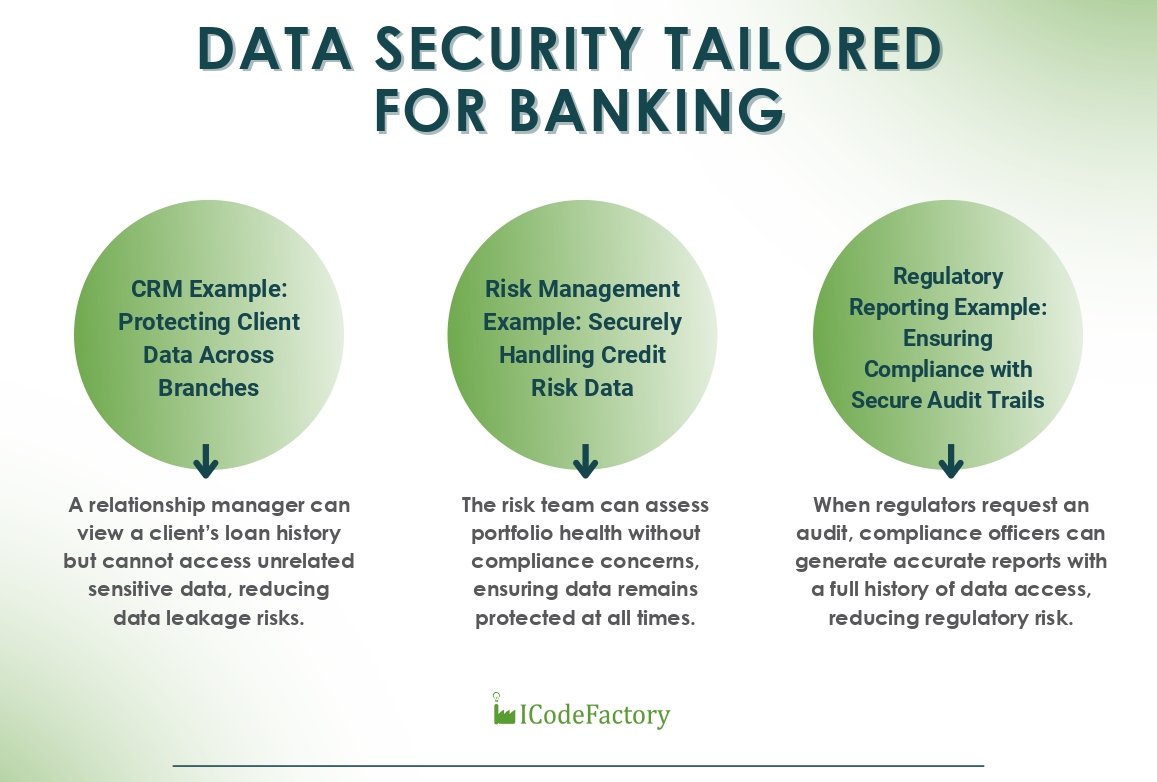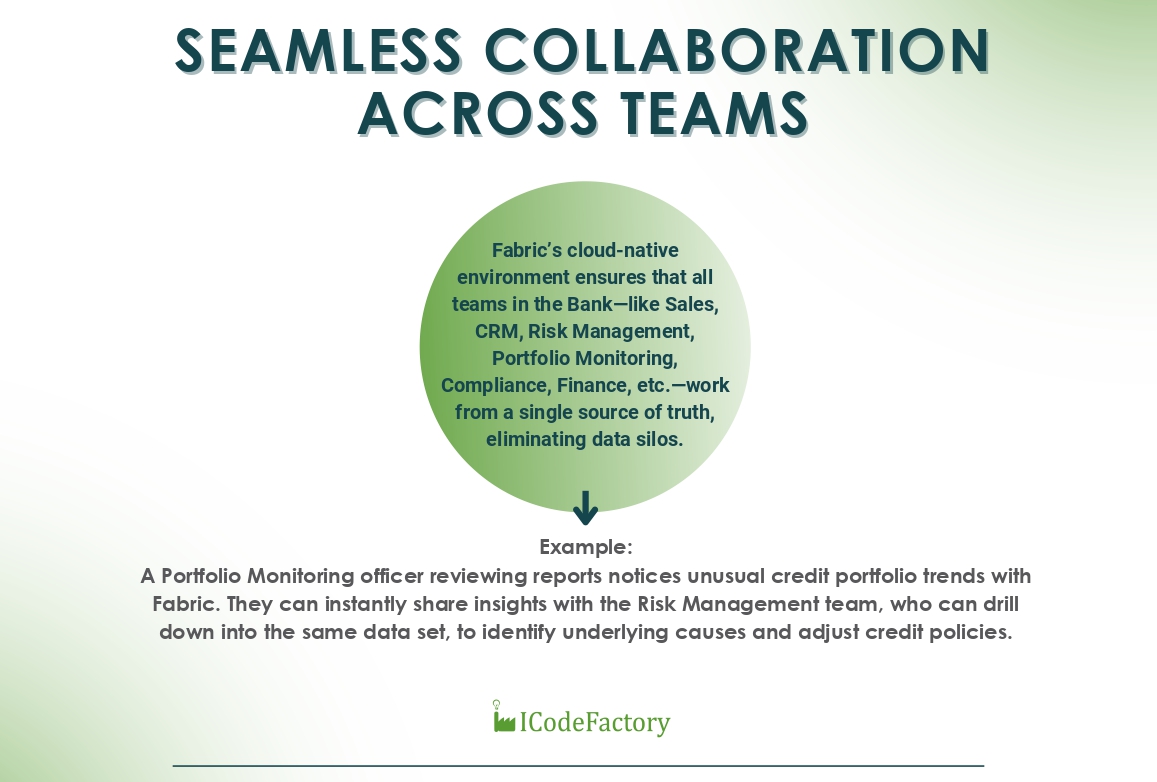Having spent years in banking, I’ve experienced the constant challenges of managing complex data effectively in a highly regulated environment.
How to handle sensitive client data? How to ensure compliance with regulations? How to make complex real-time data available quickly and easily? How to empower non-technical teams to perform advanced analytics without engagement of IT team resources?
Transitioning into IT industry, I found Microsoft Fabric to be the answer. It is a perfect digital solution that addresses all these challenges, while simplifying access to data for employees across various banking functions.
How can Fabric do that?
Because Microsoft Fabric is an end-to-end analytics and data platform designed for enterprises that require a unified solution. It encompasses data movement, processing, ingestion, transformation, real-time event routing, and report building
Let’s analyze some examples together:
1. DATA SECURITY TAILORED FOR BANKING
Data security is at the core of any banking operation, and Microsoft Fabric provides the highest level of robust data protection. With end-to-end encryption, role-based access control, and compliance with standards like GDPR, it ensures that data is always secure.
CRM Example: Protecting Client Data Across Branches
Banks operate across multiple branches, often sharing client data between relationship managers and central teams. With Fabric’s granular access controls, only authorized employees can access specific client records, ensuring privacy and preventing unauthorized data exposure.
- Outcome: A relationship manager can view a client’s loan history but cannot access unrelated sensitive data, reducing data leakage risks.
Risk Management Example: Securely Handling Credit Risk Data
A risk management team analyzing loan default trends can access sensitive credit data while ensuring that client details remain protected, anonymized, and accessible only to authorized employees. This helps maintain compliance and trust while enabling deeper insights.
- Outcome: The risk team can assess portfolio health without compliance concerns, ensuring data remains protected at all times.
Regulatory Reporting Example: Ensuring Compliance with Secure Audit Trails
Regulatory bodies require banks to maintain detailed records of financial transactions and risk assessments. Fabric automatically logs all data interactions, creating a secure audit trail for compliance reviews.
- Outcome: When regulators request an audit, compliance officers can generate accurate reports with a full history of data access, reducing regulatory risk.

2. REAL-TIME DATA INSIGHTS FOR SMARTER LOAN PORTFOLIO MANAGEMENT
Fabric seamlessly integrates data from multiple sources—loan origination models, portfolio management systems, CRM platforms, and external credit reports, providing a unified view for advanced analytics and real-time reporting.
CRM Example: Identifying High-Value Clients
Imagine your CRM and Risk teams want to identify low-risk clients with the potential for cross-selling or top-up their loan products. Using Fabric, they can combine portfolio data, transactional history, repayment behavior, and demographic information to create advanced dashboards that highlight potential cross-selling opportunities. This data can be integrated as sales support tools in a bank’s branch network or be a valuable input for sales campaigns through digital (Mobile or Internet) banking channels.
- Outcome: Relationship managers can provide the best customer experience to high-value clients, improving loan origination efficiency and increasing growth. Digital channel campaigns can be easily targeted at the best client segments to minimize risk and maximize profit.
Risk Management Example: Modeling Probability of Default
Risk teams need to assess loan portfolio quality and predict potentially high-risk segments with increased Probability of Default. With Fabric, they can seamlessly integrate historical repayment data, DPD delinquency vintage data, behavior information, transactional data, and macroeconomic indicators to build robust statistical PD models.
- Outcome: The system highlights loans with a high risk of default, enabling proactive measures both ex-post <such as restructuring offers or early collection on existing portfolios> and ex-ante <such as restrictions on future loan activities within identified problematic client segments>.
Regulatory Reporting Example: Ensuring reporting compliance with standard’s requirements (red: standard requirements)
Fabric simplifies the preparation of regulatory reports, such as those required for Basel III compliance. It can aggregate data on capital adequacy, liquidity coverage, and credit exposure from multiple systems into pre-configured templates.
- Outcome: Regulatory and statutory reporting teams can generate and submit accurate, audit-proof reports in hours instead of days, reducing operational risk and increasing efficiency.
3. MAKING ADVANCED ANALYTICS ACCESSIBLE TO ALL TEAMS
One of Fabric’s standout features is its user-friendly interface, enabling even non-technical staff to work with complex data.
CRM Use Case: Self-Service Reporting for Managers
A regional branch manager wants to analyze loan disbursement trends. Using Power BI within Fabric, they can drag and drop metrics like loan types, approval rates, sales rates, CRM lead conversions, and demographics data to create a detailed breakdown and analysis of sales results.
- Outcome: Managers quickly and easily gain actionable insights without relying on or waiting for IT, enabling fast and high quality decision-making.
Risk Management Use Case: Scenario Analysis and Stress-Testing
Risk analysts can use Fabric to simulate "what-if" scenarios, such as the impact of an economic downturn on a loan portfolio IT independently, quick and easy.
- Outcome: These simulations are easy to create in Fabric without IT assistance, providing a data-driven foundation for adjusting credit policies, planning provisions, and mitigating potential losses or budget breaches related to risk costs.
Regulatory Reporting Use Case: Automating Data Pipelines
Fabric automates the data aggregation process for regulatory filings, such as those for anti-money laundering (AML).
- Outcome: AML compliance officers can focus on analysis and oversight instead of manual data gathering, ensuring deadlines are met efficiently.
4. SEAMLESS COLLABORATION ACROSS TEAMS
Fabric’s cloud-native environment ensures that all teams in the Bank—like Sales, CRM, Risk Management, Portfolio Monitoring, Compliance, Finance, etc.—work from a single source of truth, eliminating data silos.
Example:
A Portfolio Monitoring officer reviewing reports notices unusual credit portfolio trends with Fabric. They can instantly share insights with the Risk Management team, who can drill down into the same data set, to identify underlying causes and adjust credit policies.

5. CONCLUSION
Microsoft Fabric is a transformative platform for banking, offering tailored solutions.
It combines security, advanced analytics, and a user-friendly approach for non-IT users.
From identifying cross-selling opportunities, predicting loan defaults, and ensuring compliance with regulatory standards, Fabric provides digital tool banks need to operate smarter and more effectively in an increasingly complex and competitive landscape.
If you are facing these challenges and want to address them with state-of-the-art data management tool which contains comprehensive suite of services including Data Engineering, Data Factory, Data Science, Real-Time Analytics, Data Warehouse, and Databases, contact us!
As Microsoft Partner we can support you both in implementation and trainings for MS Fabric.
Cetko Okiljevic
Head of Digital Financial Solutions @ ICodeFactory
Looking for more information? Reach out to us:ICodeFactory | Contact
